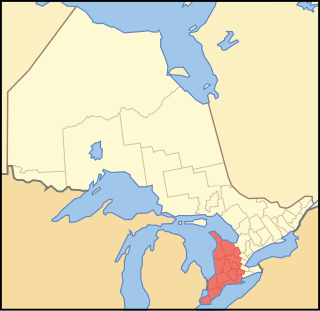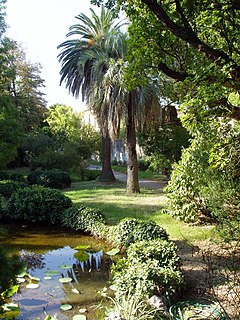
A botanical garden or botanic garden is a garden dedicated to the collection, cultivation, preservation and display of a wide range of plants labelled with their botanical names. It may contain specialist plant collections such as cacti and other succulent plants, herb gardens, plants from particular parts of the world, and so on; there may be greenhouses, shadehouses, again with special collections such as tropical plants, alpine plants, or other exotic plants. Visitor services at a botanical garden might include tours, educational displays, art exhibitions, book rooms, open-air theatrical and musical performances, and other entertainment.

The New York Botanical Garden (NYBG) is a botanical garden located in the Bronx, New York City. The 250-acre (100 ha) site's verdant landscape supports over one million living plants in extensive collections. The garden has a diversity of tropical, temperate, and desert flora, as well as programming that ranges from exhibitions in the Enid A. Haupt Conservatory to festivals on Daffodil Hill. As of 2016, over a million people visit the New York Botanical Garden annually.

Longwood Gardens is an American botanical garden. It consists of over 1,077 acres of gardens, woodlands, and meadows in Kennett Square, Pennsylvania, United States in the Brandywine Creek Valley. It is one of the premier horticultural display gardens in the United States and is open to visitors year-round to enjoy exotic plants and horticulture, events and performances, seasonal and themed attractions, as well as educational lectures, courses, and workshops.

The United States Botanic Garden (USBG) is a botanic garden on the grounds of the United States Capitol in Washington, D.C., near Garfield Circle. The U.S. Botanic Garden is supervised by the Congress through the Architect of the Capitol, who is responsible for maintaining the grounds of the United States Capitol. The USBG is open every day of the year, including federal holidays. It is the oldest continually operating botanic garden in the United States.

A conservatory is a building or room having glass or tarpaulin roofing and walls used as a greenhouse or a sunroom. If in a residence, it would typically be attached to the house on only one side. Conservatories originated in the 16th century when wealthy landowners sought to cultivate citrus fruits such as lemons and oranges that began to appear on their dinner tables brought by traders from warmer regions of the Mediterranean. Municipal conservatories became popular in the early 19th century.

The San Francisco Botanical Garden at Strybing Arboretum is located in San Francisco's Golden Gate Park. Its 55 acres represents nearly 9,000 different kinds of plants from around the world, with particular focus on Magnolia species, high elevation palms, conifers, and cloud forest species from Central America, South America and Southeast Asia.

The Arnold Arboretum of Harvard University is an arboretum located in the Jamaica Plain and Roslindale sections of Boston, Massachusetts. It was designed by Frederick Law Olmsted and is the second largest "link" in the Emerald Necklace.

Tower Hill Botanic Garden is a 171-acre botanic garden and arboretum located in Boylston, Massachusetts, approximately 8 miles (13 km) north of central Worcester in Worcester County, Massachusetts. Tower Hill features 17 distinct gardens, preserved woodlands, and miles of walking trails.

The Cheyenne Botanic Gardens are located in Lions Park in Cheyenne, Wyoming, with an associated High Plains Arboretum located five miles (8 km) northwest of Cheyenne at an elevation of 6,200 feet (1,900 m).
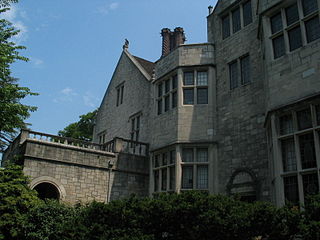
Planting Fields Arboretum State Historic Park, which includes the Coe Hall Historic House Museum, is an arboretum and state park covering over 400 acres (160 ha) located in the village of Upper Brookville in the town of Oyster Bay, New York.

The University of Michigan Matthaei Botanical Gardens includes botanical gardens, natural areas with trails, and several research-quality habitats. The conservatory is popular year round. The public entrance is at 1800 North Dixboro Road in Ann Arbor, Michigan. The grounds are open every day, but trails are not maintained in the winter. The conservatory, garden store, and lobby are open 7 days a week: Mon., Tues., and Thurs. - Sun., 10:00 am–4:30 pm; Wednesdays 10 am-8 pm. The building complex is only closed on three holidays a year. The institution's main web site with updated information is Matthaei Botanical Gardens.

The Lewis Ginter Botanical Garden, 50 acres (200,000 m2), is a botanical garden located at 1800 Lakeside Avenue, on the North Side of Richmond, Virginia. It includes the Lakeside Wheel Club built by Lewis Ginter and expanded and remodeled into Bloemendaal by his niece Grace Arents.

The Guelph Arboretum of the University of Guelph is an arboretum modeled after the Arnold Arboretum of Harvard University, which was founded in 1872. The Arnold Arboretum is privately endowed as a department of Harvard just as the Guelph Arboretum is a department of the University of Guelph. The University of Guelph Arboretum was founded in the early 1970s and plantings started in 1971 which have developed into specialized gardens, botanical collections, and gene conservation programs. These Arboretums are demonstrations of American gardening which did not come into its own until the late 19th century. With Industrialization, cities grew in size with a need for natural areas, which were included through the creation of public parks. Views of botanical gardens began to change as they became sources for new material of potential horticultural use rather than only public spaces. Today these spaces act in the propagation of plants that have the potential as attractive and functional ornamentals.
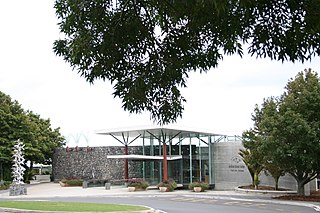
Auckland Botanic Gardens is a 64-hectare botanical garden in Manurewa, South Auckland, New Zealand, owned by Auckland Council. The first purchase of land by the Auckland Regional Authority (ARA) – predecessor of Auckland Regional Council (ARC) – dates back to 1968. Developments started in 1973. The garden was officially opened to the public in 1982. In that same year the first Visitors Guide was published. It now holds more than 10,000 plants.

Tallinn Botanic Garden, is a botanical garden in Tallinn, Estonia. It is located on the right bank of the Pirita River, in the Kloostrimetsa forest in Pirita district. With an area of 123 ha, it is the largest in Estonia.
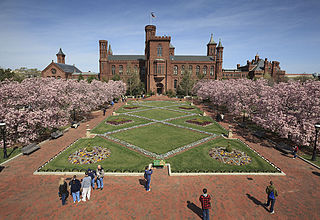
The Smithsonian Gardens, a division of the Smithsonian Institution, is responsible for the "landscapes, interiorscapes, and horticulture-related collections and exhibits", which serve as an outdoor extension of the Smithsonian's museums and learning spaces in Washington, D.C. Established in 1972 as a groundskeeping and horticulture program, Smithsonian Gardens currently manages 180 acres of gardens on the National Mall, 64,000 square feet of greenhouse production space, and the Archives of American Gardens, a research collection of over 60,000 photographs and archival records covering American landscape history from the 1870s to the present.

Niagara Parks School of Horticulture is both an educational institution and a public botanical garden that is maintained by dedicated staff and students with a united objective to educate, cultivate, and preserve ornamental plants. The school bills itself as an alternative to post-secondary training for horticulture by providing students with a 36 consecutive month program combining practical and academic studies. The School of Horticulture is part of the Niagara Parks Commission located in Niagara Falls, Ontario.
The Centre for Canadian Historical Horticultural Studies (CCHHS) includes archives and a program of scholarly study within Royal Botanical Gardens, Ontario. It focuses on collecting and preserving literature, documents, and artifacts relevant to the history of horticulture in Canada.



